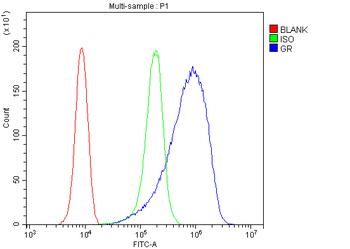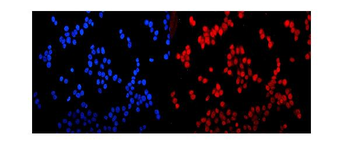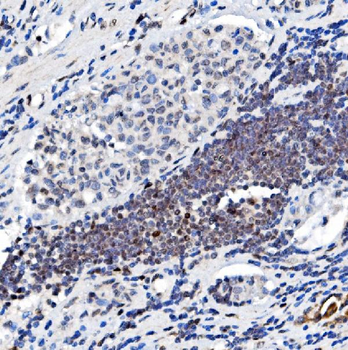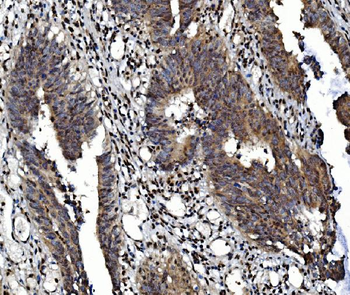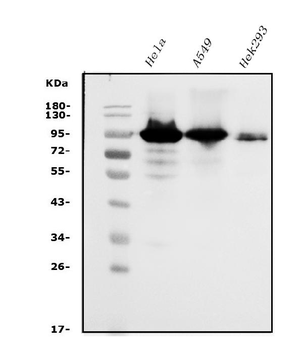You have no items in your shopping cart.
Anti-Glucocorticoid Receptor/NR3C1 Antibody
Catalog Number: orb251525
| Catalog Number | orb251525 |
|---|---|
| Category | Antibodies |
| Description | Anti-Glucocorticoid Receptor/NR3C1 Antibody |
| Species/Host | Rabbit |
| Clonality | Polyclonal |
| Tested applications | IHC, WB |
| Reactivity | Human, Mouse, Rat |
| Isotype | Rabbit IgG |
| Immunogen | E.coli-derived human NR3C1 recombinant protein (Position: A20-F199). Human NR3C1 shares 80% and 74% amino acid (aa) sequence identity with mouse and rat NR3C1, respectively. |
| Concentration | Adding 0.2 ml of distilled water will yield a concentration of 500 μg/ml. |
| Form/Appearance | Lyophilized |
| Conjugation | Unconjugated |
| MW | 100 kDa |
| UniProt ID | P04150 |
| Storage | Maintain refrigerated at 2-8°C for up to 2 weeks. For long term storage store at -20°C in small aliquots to prevent freeze-thaw cycles. |
| Alternative names | Glucocorticoid receptor; GR; Nuclear receptor subf Read more... |
| Note | For research use only |
| Application notes | Immunohistochemistry (Paraffin-embedded Section), 0.5-1μg/ml, Human, Mouse, RatWestern blot, 0.1-0.5μg/ml, Human, Mouse, Rat. Add 0.2ml of distilled water will yield a concentration of 500ug/ml |
| Expiration Date | 12 months from date of receipt. |

IHC analysis of NR3C1 using anti-NR3C1 antibody. NR3C1 was detected in a paraffin-embedded section of mouse cardiac muscle tissue. Heat mediated antigen retrieval was performed in EDTA buffer (pH8.0, epitope retrieval solution). The tissue section was blocked with 10% goat serum. The tissue section was then incubated with 1 µg/ml rabbit anti-NR3C1 Antibody overnight at 4°C. Biotinylated goat anti-rabbit IgG was used as secondary antibody and incubated for 30 minutes at 37°C. The tissue section was developed using Strepavidin-Biotin-Complex (SABC) with DAB as the chromogen.
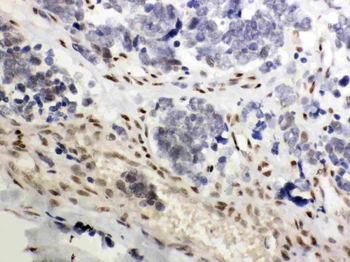
IHC analysis of NR3C1 using anti-NR3C1 antibody. NR3C1 was detected in a paraffin-embedded section of human lung cancer tissue. Heat mediated antigen retrieval was performed in EDTA buffer (pH8.0, epitope retrieval solution). The tissue section was blocked with 10% goat serum. The tissue section was then incubated with 1 µg/ml rabbit anti-NR3C1 Antibody overnight at 4°C. Biotinylated goat anti-rabbit IgG was used as secondary antibody and incubated for 30 minutes at 37°C. The tissue section was developed using Strepavidin-Biotin-Complex (SABC) with DAB as the chromogen.
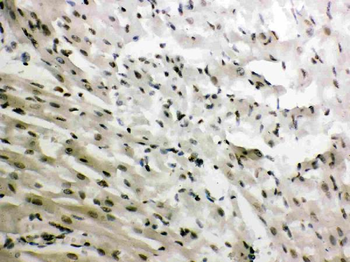
IHC analysis of NR3C1 using anti-NR3C1 antibody. NR3C1 was detected in a paraffin-embedded section of rat cardiac muscle tissue. Heat mediated antigen retrieval was performed in EDTA buffer (pH8.0, epitope retrieval solution). The tissue section was blocked with 10% goat serum. The tissue section was then incubated with 1 µg/ml rabbit anti-NR3C1 Antibody overnight at 4°C. Biotinylated goat anti-rabbit IgG was used as secondary antibody and incubated for 30 minutes at 37°C. The tissue section was developed using Strepavidin-Biotin-Complex (SABC) with DAB as the chromogen.

Western blot analysis of NR3C1 using anti-NR3C1 antibody. Electrophoresis was performed on a 5-20% SDS-PAGE gel at 70V (Stacking gel) / 90V (Resolving gel) for 2-3 hours. The sample well of each lane was loaded with 30 ug of sample under reducing conditions. Lane 1: human placenta tissue lysates, Lane 2: human Hela whole cell lysates, Lane 3: rat brain tissue lysates, Lane 4: rat liver tissue lysates, Lane 5: mouse brain tissue lysates, Lane 6: mouse liver tissue lysates. After electrophoresis, proteins were transferred to a nitrocellulose membrane at 150 mA for 50-90 minutes. Blocked the membrane with 5% non-fat milk/TBS for 1.5 hour at RT. The membrane was incubated with rabbit anti-NR3C1 antigen affinity purified polyclonal antibody at 0.5 µg/mL overnight at 4°C, then washed with TBS-0.1% Tween 3 times with 5 minutes each and probed with a goat anti-rabbit IgG-HRP secondary antibody at a dilution of 1:5000 for 1.5 hour at RT. The signal is developed using an Enhanced Chemiluminescent detection (ECL) kit with Tanon 5200 system. A specific band was detected for NR3C1 at approximately 100 kDa. The expected band size for NR3C1 is at 86 kDa.
Anti-Glucocorticoid Receptor/NR3C1 Antibody [orb215986]
FC, ICC, IF, IHC, WB
Human
Rabbit
Polyclonal
Unconjugated
100 μg, 10 μgAnti-Glucocorticoid Receptor/NR3C1 Antibody [orb2623276]
FC, ICC, IF, IHC, WB
Human
Rabbit
Polyclonal
iFluor647
100 μgAnti-Glucocorticoid Receptor/NR3C1 Antibody [orb2623277]
FC, ICC, IF, IHC, WB
Human
Rabbit
Polyclonal
PE
100 μgAnti-Glucocorticoid Receptor/NR3C1 Antibody [orb2623278]
FC, ICC, IF, IHC, WB
Human
Rabbit
Polyclonal
APC
100 μgAnti-Glucocorticoid Receptor/NR3C1 Antibody [orb2623279]
FC, ICC, IF, IHC, WB
Human
Rabbit
Polyclonal
HRP
100 μg



